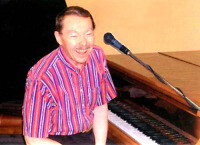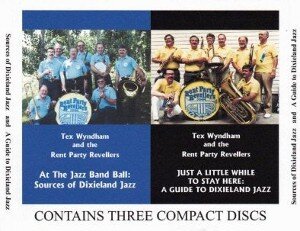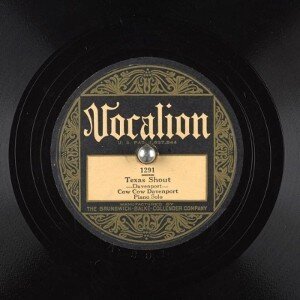 Set forth below is the forty-ninth “Texas Shout” column. It first appeared in the April 1994 issue of The West Coast Rag, now known as The Syncopated Times. I have tacitly deleted the contact information for the now-defunct Syracuse Cinefest and replaced the contact information for the Society Of Cinephiles with the latest information available to me.
Set forth below is the forty-ninth “Texas Shout” column. It first appeared in the April 1994 issue of The West Coast Rag, now known as The Syncopated Times. I have tacitly deleted the contact information for the now-defunct Syracuse Cinefest and replaced the contact information for the Society Of Cinephiles with the latest information available to me.
Not long ago I learned of the recent discovery of a clip of sound film that shows a few seconds of Bix Beiderbecke soloing on cornet. I haven’t seen it yet, but the news reminds me of some experiences with vintage films that might be of interest to WCR’s readers.
As many of you know, Nancy and I are deeply into movies. We watch over 300 features a year, almost all of them via cable or VCR.
(We gave up going to the theater. Not only is it expensive, but the audiences are often loud and otherwise rude. Further, the films are sometimes projected at the wrong aspect ratio. If we want to see films at the wrong aspect ratio, we can do it more cheaply and comfortably at home.)
Years ago I was historian and host for the last vintage film society to function here in Wilmington. A fair amount of the courtship between Nancy and myself occurred at drive-in double features (no off-color remarks, please). The first summer of our marriage, we drove an hour to Germantown several times a week to a movie house that was showing a summer of classic-period features.
Shortly after we were married in 1971, we began attending special film fans’ weekends. These are much like Dixieland festivals, except that instead of digging various combos from dawn until the wee hours, attendees watch rare old (usually pre-1940) movies and sometimes meet stars or other persons active in the production thereof.
In recent years, we’ve been attending a fabulous function in Syracuse every March, the Syracuse Cinefest. Most of the time, we watch the films projected in 16 millimeter in a hotel ballroom, but once during the weekend we visit a nearby cinema for special 35mm screenings.
In 1993, the special showings were at a restored downtown movie palace. A highlight was to be “Her Sister From Paris,” a 1925 silent from the Library Of Congress collection that turned out to be a delightful Constance Talmadge-Ronald Colman romantic comedy. We were promised some early Vitaphone sound shorts, but were not told what they would be.
Imagine my amazement when one of them turned out to feature Red Nichols! I couldn’t readily identify the entire sextet, but banjo/guitarist Eddie Condon (who sings two vocals) and reedman Pee Wee Russell are unmistakable. Five numbers are played, the second a ballad in which Nichols is joined by two trumpeters. The show ends with “China Boy,” a romping ride that’s hotter’n a pistol.
I couldn’t believe it. Here, captured on sound film at the very beginning of their careers, when no one had any reason to think they would become legendary figures of jazz, were Condon and Russell, not to mention Nichols, a personal favorite of mine, still young but already well known.
The twenties, the decade of most interest to hard-core Dixieland buffs, was almost over before sound film came along. The principal groundbreaking developments in Dixieland had already gone by. The main body of jazz was starting to incorporate changes that would evolve into swing. There are a few films of great jazz figures from that period – the famous Ellington and Bessie Smith shorts come to mind – but nothing at all of such magical and important groups as, say, the Red Hot Peppers, the Wolverines, the Hot Five, etc.
A similar experience took place a few months later, at the 1993 convention of the Society For Cinephiles, held over the Labor Day weekend each year. (To get wired in, contact www.cinecon.org) One of the features was a 1915 silent, “The Whirl Of Life,” a tongue-in-cheek biography of Vernon and Irene Castle, with the Castles themselves in the leading roles.
It was engrossing enough to see these two artists, whose influence on the popular musical styles of the 1920s was considerable. However, as the topper, the feature closes with an extended dance routine by the Castles in a nightclub.
If you watch the corner of the frame, you’ll see bits and pieces of the Castles’ regular accompanists, the orchestra of James Reese Europe, perhaps the most important Black musician in New York City during the early years of this century. Parts of the band are also shown in full-frame closeup for a few seconds.
The movie, as I’ve said, is silent. Nevertheless, it is of considerable interest to anyone concerned with jazz history, as it presents live footage of Europe, whose Society Orchestra made in 1913 the first recordings by an all-Black dance band. Probably also in this sequence somewhere is Ford Dabney, composer of “Shine” and a number of fine piano rags, who was Europe’s pianist and assistant director.
The film also includes a brief closeup of the drummer, maybe Buddy Gilmore, a featured Europe sideman. In an earlier tavern sequence, a Black instrumental trio is shown on stage, probably also members of Europe’s aggregation.
I’ve been a movie buff all my life, my parents taking my sister Dallas (also a nickname) and me to every film that appeared at the Edge Moor (the closest movie house to our neighborhood), except for the really scary movies (which we saw anyway at the Saturday matinee). I’ve also been crazy about Dixieland and ragtime since I was a kid decades ago.
(Tavern Scene runs from 31:20-31:48. If you can identify the musicians contact The Syncopated Times.)
However, I had never heard of “The Whirl Of Life,” nor did I know that there were any extant movie scenes of James Reese Europe. I asked Miles Krueger, who introduced the film, and who knew Irene Castle personally, if the jazz world was aware of the existence of this movie. He didn’t know the answer specifically but told me that the feature was no secret, having been a part of the Museum Of Modern Art’s collection for (I think he said) at least some thirty years.
This incident reminds me all over again how little intersection there is between the vintage film community and the vintage jazz community. To be sure, there is a small handful of people who specialize in collecting film footage of jazzmen. There is even a book attempting to list appearances by jazzmen in movies, Jazz In The Movies, by Donald Meeker. (It doesn’t list “The Whirl Of Life,” either because Meeker didn’t know about it or because Europe was really a pre-jazz personality and might have been thought to be outside the scope of the book.)
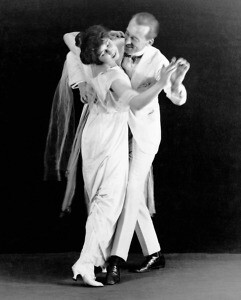
However, despite the recent proliferation of music videos, including ones concentrating on jazz and ragtime, there is relatively little discussion of jazz on film in the present-day jazz periodicals. (The excellent British jazz magazine Jazz Journal, is an exception, having carried a regular column on the topic for years.) Similarly, jazz films are not commonly presented as part of Dixieland festival weekends, possibly because (from what I know of the few attempts to do so) such presentations are poorly attended.
This latter situation is unfortunate. With most of the great pioneering players no longer around, seeing them on film is an easy, inexpensive and accessible way to appreciate their talents.
We have many people today not only attending jazz performances, but even posing as authorities on the subject, who really are not very well grounded in what they’re seeing or talking about. Some exposure to the great musicians on film might go some way toward relieving that situation.
I got my first indoctrination into the byways of jazz film collecting over twenty years ago, during a discographical conference that Nancy and I attended at Rutgers University. It included a fascinating seminar thereon, together with film clips, by Ernie Smith, an expert on jazz films. Two of the points Ernie made that day stuck in my mind.
First, he said that, if you are interested in jazz, and if you are watching a movie in which instrumentalists appear in the shot, you must condition yourself to stop watching the main action immediately and begin looking around the edges of the frame. He reminded us that in many cases, unless the musicians are featured performers in the film, the players are just there for atmosphere, will be on screen for a few seconds at most, and then only in an incidental way. You will have virtually no time to try to identify them.
Second, and I think I’m recalling this point correctly, he said that, in the earliest films, if Black musicians appear on screen, there is a good chance that they are real musicians and not actors. I believe his theory was that it was easier and cheaper for the film companies to hire organized Black bands, which already had instruments and uniforms, than to bother with recruiting Black actors and outfitting them.
It was shortly after that conference that Nancy and I attended our first Cinephiles convention, in Washington, D.C. We were overwhelmed at the large number of rare movies spread out for our delectation (calling for agonizing choices between different films being shown simultaneously in the two screening rooms), the inclusion of rediscovered features we had been led to believe were lost (we were astonished to see “White Gold,” a 1927 silent with Jetta Goudal), and the chance to meet live big-name stars of the old days (Leatrice Joy, star of C.B. DeMille’s “Saturday Night” in 1922, still looked like a million dollars and exuded high class from every pore).
Thus, we were still starry-eyed as we settled in to watch an early 1920s version of “Camille” starring Alla Nazimova and Rudolph Valentino. Perhaps, then, and with Ernie Smith’s admonitions still fresh in my mind, I saw what I hoped I would see and not what I actually saw. However, I’m getting ahead of my story.
“Camille” contains a sequence in which the leading character goes to a casino and is taken ill. The set for the casino is a highly-stylized two-story affair, with a small triangular opening in a second-story wall overlooking the gambling floor.
As the scene opens, we are given a flash of this opening in closeup, which was just big enough to hold the three Black musicians crowded into it. As the image flashed by, I whispered to Nancy “That looked like Johnny Dodds!”
We both went on the alert, but the musicians only appeared once more on the screen, in a distance shot. They were briefly seen as they leaned out of the alcove to watch the crowd gather around the collapsed Camille.
Immediately after the showing, we went out in the lobby and looked up the film in an American Film Institute catalogue at the convention’s main desk. As we expected, there was no cast credit for such a fleeting glimpse of the musicians.
Upon returning home, I compared the date of the movie as shown in our convention program with the date of the famous 1921 photograph of King Oliver’s band taken during its California tour. I was excited to find that the timing seemed to allow for the possibility that at least some of Oliver’s combo could have appeared in the casino sequence of “Camille.”
I have repeated this story to Ernie Smith and to every other collector of jazz films with whom I’ve come in contact. I’ve also asked a few of the film people at our film weekends about it, but they are, understandably, not as interested in using their limited time to track down this detail of jazz history as they are to track down more central points of film history. If anyone has ever followed up this matter and either confirmed the identity of the musicians, or obtained a still print of the frames involved, I’m unaware of it.
I seem to recall that, in addition to the clarinetist, one of the “Camille” musicians was playing a banjo. I think the third musician was a pianist, sitting so as to face the right of the frame with the piano obscured behind the wall of the alcove.
However, the shot went by so fast that I can’t be sure of anything. Lil Hardin was Oliver’s pianist on that trip, but if there was a pianist in the frame, it went by so fast that the sex of the player did not register on my memory.
Most likely, I was the victim of a fevered imagination combined with a star-struck sensibility. However, until the musicians in Valentino’s “Camille” are identified, the story is a good one for cold winter nights.
Moreover, silent or sound, wouldn’t it be something if there was motion picture footage – albeit silent and extremely short – of even a segment of Oliver’s immortal Creole Jazz Band? If, sixty years after his death, we can come up with a sound sequence on Bix, maybe such a dream isn’t beyond the pale after all.
* * * * *
(The following addendum was added to a reprint of this essay in 1999)
Since writing the above words, I have acquired a commercially released videocassette of Valentino’s “Camille.” The band in the casino sequence is shown twice in closeup, each shot lasting about two seconds – too short for my VCR to get a freeze-frame that is clear enough to identify the musicians.
(The closeups are at 53:38, and 56:07, as far as we know the musicians have still been not identified, if you know who they are please contact TST.)
Despite what I thought I saw the first time, the combo consists of five males, playing (left to right) saxophone, clarinet, trumpet (or cornet — the sequences go by too fast for me to be certain), trombone and drums (the drums being actually below and to the right of the frame line). This instrumentation is consistent with that of the band Oliver took to California at that time.
The musicians are also shown twice in distance shots for a total of about seven seconds. However, the print used for my copy is somewhat darker and less clear than studio quality, so I am not able to use these shots to aid in identifying the personnel.
Also, I have now seen what I believe is the clip of Bix mentioned at the beginning of the article. It is from a newsreel that shows the Paul Whiteman Orchestra. Bix stands up briefly, and is clearly recognizable, but does not play.
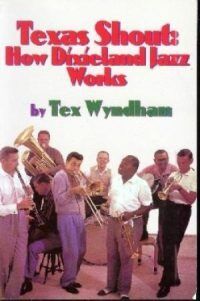 Want to read ahead? Buy the book!
Want to read ahead? Buy the book!
The full run of “Texas Shout” has been collected into a lavishly illustrated trade paperback entitled Texas Shout: How Dixieland Jazz Works. This book is available @ $20.00 plus $2.95 shipping from Tex Wyndham, On request, Tex will autograph the book and add a personalized note (be sure to tell him to whom the note should be addressed).
Tex Wyndham’s 3 CD Guide to Dixieland with music and commentary is available for $20 plus $2.95 shipping. The separate CD, A History of Ragtime: Tex Wyndham Live At Santa Rosa, is available for $13.00 plus $2.00 shipping. On request, Tex will autograph the inner sleeve and add a personalized note (be sure to tell him to whom the note should be addressed).
Send payment to Tex Wyndham, P.O. Box 831, Mendenhall, PA 19357, Phone (610) 388-6330.
Note: All links, pictures, videos or graphics accompanying the Shouts were added at the discretion of the Syncopated Times editorial staff. They did not accompany the original columns and do not necessarily reflect the opinion of Tex Wyndham.
From roughly 1970-2010, Tex Wyndham was: (1) one of the best-known revivalist Dixieland jazz musicians in the US, as cornetist, pianist and bandleader, (2) one of the best-known ragtime pianists in the US, and (3) one of the most respected critics in the US of Dixieland jazz, ragtime, and related music. He is the only person about whom all three of those statements can be made.

